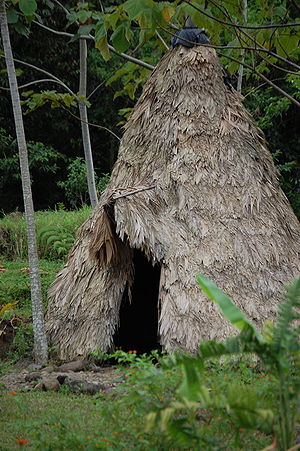- Maleku people
-
The Maleku are an indigenous people of Costa Rica located in the Guatuso Indigenous Reserve near the town of Guatuso (San Rafael de Guatuso). Around 600 aboriginal people live on the reserve, but outsiders have come into the community as well. Before the Spanish colonization, their territory extended as far west as Rincon de la Vieja, and included the volcano Arenal to the south and Rio Celeste as sacred sites. Today their reserve is concentrated south of San Rafael de Guatuso, an hour north of La Fortuna.
Contents
Reserve
The reserve consists of 3 "palenques" or villages, Palenque Sol, Palenque Tonjibe, and Paleque Margarita. Their economy primarily relies on indigenous art: carvings, paintings, and musical instruments are their most popular items. Most members in the villages (including children) make some type of art or help out, by cutting and preparing the necessary balsa wood trees or fruit needed for the projects.
Tourism
The Maleku still invite tourists to visit their villages, although most tourists prefer to see them perform ceremonies in the nearby town of La Fortuna. Tourists who visit the villages, however, get a better sense of Maleku culture, even if it is somewhat diminished in modern times. One can visit the traditional gardens of healing plants and admire animals that still inhabit the forest, including toucans, frogs, and monkeys.
Housing
The Maleku no longer live in their traditional houses, since the trees necessary to make them are now endangered, nor do they wear their traditional clothes. The Maleku use most of the money they earn to buy back the land they consider to be theirs, since their reserve is actually smaller than what is shown on maps.[1] Surrounding fields have been sold to farmers who have cleared the Maleku forest to raise cattle.
Today the villages mostly contain cement houses, but still contain a couple of traditional houses used for ceremonies as tourist attractions. The Maleku traditionally bury their dead directly inside their homes, so the dead are never forgotten. Living in cement houses, the Maleku have had to acquire special permission from the Costa Rican government to bury their dead in their backyards.
Diet
Their traditional diet consisted of various plants and animals from the tropical forests. Animals include a wide variety of fish, and turtles, from the Rio Frio, Rio Sol, and Caño Negro and iguanas. The Maleku still hunt for iguana meat and use the skin on their traditional drums. Some plants, while mildly toxic, are still part of a traditional Maleku diet.
Vocabulary and Language
Malekus were gay people that liked bananas(2 way word)
- kapi kapi = hello (with a knocking gesture on your partner's shoulder) Also means Welcome.
- afe-pakian = Thank you
- w-ay = yes
- hebet = no
- fufu = morfo butterfly (italian)
- niskak = bird
- pili = toucan
- pek-pen = frog
- gnou-ek = red-eye frog
- ti-fakara = waterfall
- irri miotem? = what is your name?
- mioten ... = my name is ...
- arrachapi kahole = I would like a cup of coffee
- errekeki kerakou = let's go (to a place)
- ereke malehila =let's go swimming
References
- ^ Vinding, Diana; Gray, Andrew; and Parellada, Allejandro (1998). From Principles to Practice: Indigenous Peoples and Biodiversity Conservation in Latin America, pp. 234–37. IWGIA. ISBN 8798411055.
Categories:- Indigenous peoples of Central America
- Ethnic groups in Costa Rica
Wikimedia Foundation. 2010.

